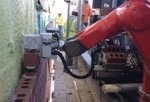February 2015
New robotics system takes tedium out of masonry, freeing masons for more detailed work.
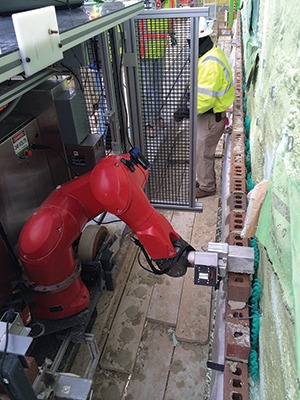
Robotics continues to shake up industries throughout the economy, including medicine, transportation, manufacturing and others for which repetitive tasks can be automated to improve accuracy and productivity.
It’s only logical that robotics will eventually become more widely used in construction, where time and accuracy are vital to profits. Although the construction industry has yet to see widespread use of robotic devices on jobsites, one company may be about to change that for the masonry segment.
Construction Robotics will launch commercial production of its Semi-Automated Masonry (SAM) robotic system this year. The device is an automated bricklaying system that helps masons by doing much of the lifting and placing of bricks that masons traditionally have done by hand. By taking over the heavy lifting, SAM leaves masons free to focus on detail work, quality control and other tasks requiring more finesse.
“We see a ton of opportunities; this is a ripe industry,” says Scott Peters, co-founder of Construction Robotics. “Any place where there is repetitive action, there is an opportunity to leverage robotics and other manufacturing principles to be more cost effective.”
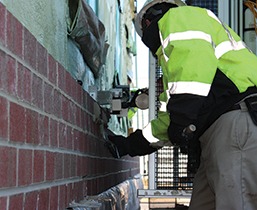
SAM can lay about 230 modular through utility-sized bricks per hour, whereas the typical brick mason lays around 300 to 500 per day. Masons using the device are able to focus on tooling joints, monitoring wall quality and performing tasks such as installing insulation, wall ties and lintels. The makers of SAM estimate the device could yield 30 percent in cost savings to masonry companies, allowing them to be more competitive.
Michael Manning, owner of Manning Construction in Highland Springs, Va., got to see SAM at work on a recent barracks construction project at Fort Lee. SAM was used to help erect a sizable length of brick wall on the barracks project. Manning says he was impressed by the rugged construction of the device and its ability to quickly and accurately lay brick.
“I think they’re on the right path,” Manning says. “In the future, whether it’s a year from now or two years from now, they will have a major impact on the industry.”
How it works
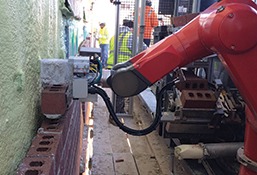
SAM is a user-friendly, robust device that will be easy to use on the work site and will require minimal set up and maintenance.
SAM is transported easily from site to site in a trailer towed behind a pickup. Using a telehandler, SAM is placed on a track that is pre-mounted on a mast climber. Once SAM is in place, the mason will set up a target story pole on one end of the work area and SAM’s laser story pole on the other end, similar to how masons set string lines. Masons then load a map file into SAM that teaches the robot the pattern of the wall it will construct. The mason next takes a few measurements, enters them into the system, aligns SAM with the wall and activates the device. The device is loaded with bricks and mortar, and SAM is ready to run.
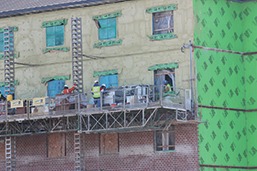
“The mason shows the robot where the laser is on the wall,” Peters says. “The robot sees the laser, and figures out where the first brick is placed and goes to work.”
SAM currently is compatible with the Hydro-Mobile M2 mast climber system. Work is underway to make the system compatible with other mast climbers.
Peters says SAM is easy to learn. Companies purchasing the device will be able to send masons to a one-week training course that will teach them all the skills they need to effectively operate it. Construction Robotics also offers exemplary product support to its clients, Peters says.
“Purchasers of SAM are partners of ours,” he says. “We want them to be successful.”
SAM is best suited for work on lengthy brick walls. With a price tag of $650,000, large masonry firms are currently the best fit for the device, although Peters says leasing and rental programs will eventually allow smaller masonry firms to use SAM as well. Masonry companies that purchase SAM can expect a return on their investment within three years.
SAM is designed to withstand the hazards of the construction jobsite. The device is expected to have a working life of about 10 years. Peters says the most common maintenance work that owners will have to perform is changing the generator’s oil.
The indispensable mason
The one thing SAM won’t do is eliminate masonry jobs. According to the Bureau of Labor Statistics, the number of jobs for brick masons, stone masons and block masons will grow by 34 percent during the next decade. SAM offers masons a chance to do their jobs better; rather than competing for their jobs. While SAM will do the heavy lifting of bricklaying, masons will still be needed to monitor the device and operate it.
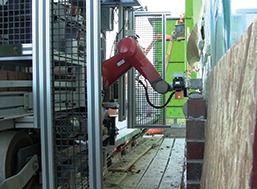
One of the key benefits of SAM for workers is that it will allow them to complete jobs more quickly and with greater accuracy, allowing them to take on more work and increase profits. Zak Podkaminer, Construction Robotics operations manager, says SAM has the potential to make masonry a more attractive profession for technically adept workers.
“We’ve actually received positive feedback from the industry,” Peters says. “Many masons realize as new technology comes online, it creates opportunities for the industry to grow and be more competitive. Hopefully it will allow masonry to be more open to people interested in technology and what it can bring to the table.”
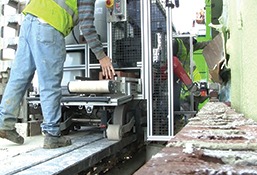
SAM can make life easier for working masons. The device can make laying bricks less labor intensive for masons, sparing them from the repetitive up-and-down movement of laying bricks and extending their careers.
“SAM definitely improves the health aspects of masonry, particularly the impact of the work on masons’ backs,” Podkaminer says. “Currently, masons lift the equivalent of two to three pickup trucks each week.”
Jim Cook is a freelance writer based in Dothan, Ala. A veteran of daily newspapers and trade publications, he has experience writing on a variety of topics. He can be reached at jim.cook.is@gmail.com. Construction Robotics was founded in 2007 by Nate Podkaminer and Scott Peters. For more information, contact them at zpodkaminer@construction-robotics.com or speters@construction-robotics.com.
Product to WatchPermeable Design Pro Software Version 2.0 |
|
• Register: www.icpi.org/picpdesignprowebinar |
